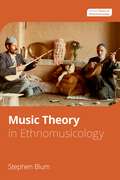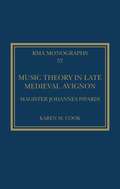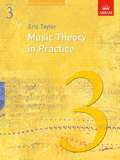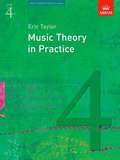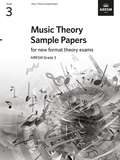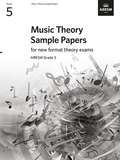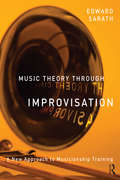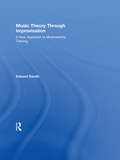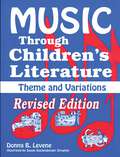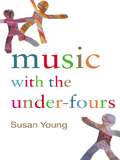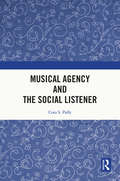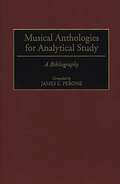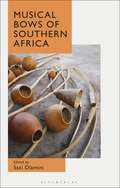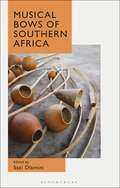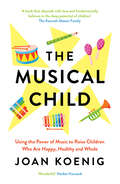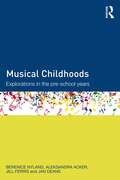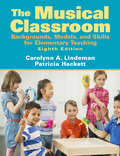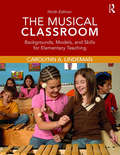- Table View
- List View
Music Theory in Ethnomusicology (Oxford Theory in Ethnomusicology)
by Stephen BlumDuring the 1960s and 70s some ethnomusicologists formed relationships with music-makers and ritual specialists in an attempt to interpret how they understood their musical actions. Subsequently ethnomusicologists have studied the respects in which explicit and implicit theory is involved in communication of musical knowledge. They have observed the production of music theory in institutions of modern nation-states and have sought out groups and individuals whose theorizing is not constrained by existing institutions. They are assessing the extent to which musical terminologies of diverse languages can be interpreted in relation to general concepts without imposing the assumptions and biases of one body of existing theory. That exercise is increasingly recognized as a necessary effort of decolonization. A thorough yet concise introduction to this field, Music Theory in Ethnomusicology outlines a conception of music theory suited to cross-cultural research on musical practices.
Music Theory in Ethnomusicology (Oxford Theory in Ethnomusicology)
by Stephen BlumDuring the 1960s and 70s some ethnomusicologists formed relationships with music-makers and ritual specialists in an attempt to interpret how they understood their musical actions. Subsequently ethnomusicologists have studied the respects in which explicit and implicit theory is involved in communication of musical knowledge. They have observed the production of music theory in institutions of modern nation-states and have sought out groups and individuals whose theorizing is not constrained by existing institutions. They are assessing the extent to which musical terminologies of diverse languages can be interpreted in relation to general concepts without imposing the assumptions and biases of one body of existing theory. That exercise is increasingly recognized as a necessary effort of decolonization. A thorough yet concise introduction to this field, Music Theory in Ethnomusicology outlines a conception of music theory suited to cross-cultural research on musical practices.
Music Theory in Late Medieval Avignon: Magister Johannes Pipardi (Royal Musical Association Monographs)
by Karen M. CookThe manuscript Seville, Biblioteca Colombina y Capitular 5-2-25, a composite of dozens of theoretical treatises, is one of the primary witnesses to late medieval music theory. Its numerous copies of significant texts have been the focus of substantial scholarly attention to date, but the shorter, unattributed, or fragmentary works have not yet received the same scrutiny. In this monograph, Cook demonstrates that a small group of such works, linked to the otherwise unknown Magister Johannes Pipudi, is in fact much more noteworthy than previous scholarship has observed. The not one but two copies of De arte cantus are in fact one of the earliest known sources for the Libellus cantus mensurabilis, purportedly by Jean des Murs and the most widely copied music theory treatise of its day, while Regulae contrapunctus, Nota quod novem sunt species contrapunctus, and a concluding set of notes in Catalan are early witnesses to the popular Ars contrapuncti treatises also attributed to des Murs. Disclosing newly discovered biographical information, it is revealed that Pipudi is most likely one Johannes Pipardi, familiar to Cardinal Jean de Blauzac, Vicar-General of Avignon. Cook provides the first biographical assessment for him and shows that late fourteenth-century Avignon was a plausible chronological and geographical milieu for the Seville treatises, hinting provocatively at a possible route of transmission for the Libellus from Paris to Italy. The monograph concludes with new transcriptions and the first English translations of the treatises.
Music Theory in Late Medieval Avignon: Magister Johannes Pipardi (Royal Musical Association Monographs)
by Karen M. CookThe manuscript Seville, Biblioteca Colombina y Capitular 5-2-25, a composite of dozens of theoretical treatises, is one of the primary witnesses to late medieval music theory. Its numerous copies of significant texts have been the focus of substantial scholarly attention to date, but the shorter, unattributed, or fragmentary works have not yet received the same scrutiny. In this monograph, Cook demonstrates that a small group of such works, linked to the otherwise unknown Magister Johannes Pipudi, is in fact much more noteworthy than previous scholarship has observed. The not one but two copies of De arte cantus are in fact one of the earliest known sources for the Libellus cantus mensurabilis, purportedly by Jean des Murs and the most widely copied music theory treatise of its day, while Regulae contrapunctus, Nota quod novem sunt species contrapunctus, and a concluding set of notes in Catalan are early witnesses to the popular Ars contrapuncti treatises also attributed to des Murs. Disclosing newly discovered biographical information, it is revealed that Pipudi is most likely one Johannes Pipardi, familiar to Cardinal Jean de Blauzac, Vicar-General of Avignon. Cook provides the first biographical assessment for him and shows that late fourteenth-century Avignon was a plausible chronological and geographical milieu for the Seville treatises, hinting provocatively at a possible route of transmission for the Libellus from Paris to Italy. The monograph concludes with new transcriptions and the first English translations of the treatises.
Music Theory In Practice, Grade 3 (PDF)
by Eric TaylorThe Music Theory in Practice series has helped more than one million musicians worldwide to learn about the notation and theory of music. Revised in 2008, this workbook remains the best way to prepare for ABRSM's Grade 3 Theory of Music Exam. Features a clear explanation of music notation, many worked examples and practice exercises, definitions of important words and concepts, specimen exam questions and helpful tips for students. As well as supporting the ABRSM Theory syllabus, this workbook also provides an excellent resource for anyone wishing to develop general music literacy skills.
Music Theory In Practice, Grade 4 (Music Theory In Practice (abrsm) Ser.)
by Eric TaylorThe Music Theory in Practice series has helped more than one million musicians worldwide to learn about the notation and theory of music. Revised in 2008, this workbook remains the best way to prepare for ABRSM's Grade 4 Theory of Music Exam. Features a clear explanation of music notation, many worked examples and practice exercises, definitions of important words and concepts, specimen exam questions and helpful tips for students. As well as supporting the ABRSM Theory syllabus, this workbook also provides an excellent resource for anyone wishing to develop general music literacy skills.
Music Theory Practice Papers 2022, ABRSM Grade 5 (Music Theory Practice Papers 2022)
by AbrsmABRSM’s official Music Theory Practice Papers 2022 are essential resources for candidates preparing for our online Music Theory exams. They provide authentic practice material and are a reliable guide as to what to expect in the exam. -Essential practice material for ABRSM Grade 5 Theory exams -Model answers also available.
Music Theory Sample Papers [2020], ABRSM Grade 3
by AbrsmABRSM’s official Music Theory Sample Papers are essential resources for candidates preparing for our Music Theory exams. They provide authentic practice material and are a reliable guide as to what to expect in the exam.
Music Theory Sample Papers, ABRSM Grade 5: for new format Music Theory exams from 2020
by AbrsmABRSM’s official Music Theory Sample Papers are essential resources for candidates preparing for our Music Theory exams. They provide authentic practice material and are a reliable guide as to what to expect in the exam.
Music Theory Through Improvisation: A New Approach to Musicianship Training
by Ed SarathDesigned for Music Theory courses, Music Theory Through Improvisation presents a unique approach to basic theory and musicianship training that examines the study of traditional theory through the art of improvisation. The book follows the same general progression of diatonic to non-diatonic harmony in conventional approaches, but integrates improvisation, composition, keyboard harmony, analysis, and rhythm. Conventional approaches to basic musicianship have largely been oriented toward study of common practice harmony from the Euroclassical tradition, with a heavy emphasis in four-part chorale writing. The author’s entirely new pathway places the study of harmony within improvisation and composition in stylistically diverse format, with jazz and popular music serving as important stylistic sources. Supplemental materials include a play-along Audio CD for improvisation and a companion website with resources for students and instructors.
Music Theory Through Improvisation: A New Approach to Musicianship Training
by Ed SarathDesigned for Music Theory courses, Music Theory Through Improvisation presents a unique approach to basic theory and musicianship training that examines the study of traditional theory through the art of improvisation. The book follows the same general progression of diatonic to non-diatonic harmony in conventional approaches, but integrates improvisation, composition, keyboard harmony, analysis, and rhythm. Conventional approaches to basic musicianship have largely been oriented toward study of common practice harmony from the Euroclassical tradition, with a heavy emphasis in four-part chorale writing. The author’s entirely new pathway places the study of harmony within improvisation and composition in stylistically diverse format, with jazz and popular music serving as important stylistic sources. Supplemental materials include a play-along Audio CD for improvisation and a companion website with resources for students and instructors.
Music through Children's Literature (Through Children's Literature)
by Donna LeveneDevelop music appreciation among your students with folk songs, rhythmic poems, stories with musical themes, and picture books with strong musical links. Designed for teaching flexibility, these lessons can be adapted according to a teacher's level of musical proficiency and time limitations. Sections cover rhythm, melody, form, instruments, music history, and dance forms, with lively activities that involve singing, playing instruments, chanting, and movement. These are perfect for the nonmusician who is teaching music as well as the seasoned music specialist.
Music with the Under-Fours
by Susan YoungThe importance and value of music in the care and education of very young children is increasingly recognised. This book looks closely at early musical development and how this translates into ways of supporting the musical activity of babies, toddlers and young children, keeping in mind the diversity of preschool work. Key topics include: pre- and post-natal musical experience musical parenting lullabies and play songs baby music sessions toddlers' music play songs, musical games and other activities young children's singing music play with instruments listening working with adults to develop musical opportunities. This text provides a valuable synthesis of recent thinking in this area, as well as practical suggestions for fostering creativity through musical activities. An original and inspiring book which will be welcomed by anyone responsible for the care and education of preschool children.
Music with the Under-Fours
by Susan YoungThe importance and value of music in the care and education of very young children is increasingly recognised. This book looks closely at early musical development and how this translates into ways of supporting the musical activity of babies, toddlers and young children, keeping in mind the diversity of preschool work. Key topics include: pre- and post-natal musical experience musical parenting lullabies and play songs baby music sessions toddlers' music play songs, musical games and other activities young children's singing music play with instruments listening working with adults to develop musical opportunities. This text provides a valuable synthesis of recent thinking in this area, as well as practical suggestions for fostering creativity through musical activities. An original and inspiring book which will be welcomed by anyone responsible for the care and education of preschool children.
Musical Agency and the Social Listener
by Cora S. PalfyMusic as a narrative drama is an intriguing idea, which has captured explicit music theoretical attention since the nineteenth century. Investigations into narrative characters or personae has evolved into a sub-field—musical agency. In this book, Palfy contends that music has the potential to engage us in social processes and that those processes can be experienced as a social interaction with a musical agent. She explores the overlap between the psychological processes in which we participate in order to understand and engage with people, and those we engage in when we listen to music. Thinking of musical agency as a form of social process is quite different from existing theoretical frameworks for agency. It implies that we come to musical analysis by way of intuition—that our ideas are already partially formed based on our experience of the piece (and what it makes us feel or how it makes us sense it as any other) when we choose to analyze and interpret it. Palfy’s focus on social processes is a very effective way to pinpoint when and why it is that our attention is captured and engaged by musical agents.
Musical Agency and the Social Listener
by Cora S. PalfyMusic as a narrative drama is an intriguing idea, which has captured explicit music theoretical attention since the nineteenth century. Investigations into narrative characters or personae has evolved into a sub-field—musical agency. In this book, Palfy contends that music has the potential to engage us in social processes and that those processes can be experienced as a social interaction with a musical agent. She explores the overlap between the psychological processes in which we participate in order to understand and engage with people, and those we engage in when we listen to music. Thinking of musical agency as a form of social process is quite different from existing theoretical frameworks for agency. It implies that we come to musical analysis by way of intuition—that our ideas are already partially formed based on our experience of the piece (and what it makes us feel or how it makes us sense it as any other) when we choose to analyze and interpret it. Palfy’s focus on social processes is a very effective way to pinpoint when and why it is that our attention is captured and engaged by musical agents.
Musical Anthologies for Analytical Study: A Bibliography (Music Reference Collection)
by James E. PeronePresenting detailed information about 14 standard anthologies, this useful music reference tool lists all excerpts and complete compositions, provides information concerning the type of score presented, and includes an index of composers and sources as well as an index of complete compositions and movements. The book is designed primarily for researchers and teachers of music theory to make the search for analytical source material easier and faster than previously possible. The anthologies cited are all currently in print or are generally available in music libraries.The book lists all excerpts, complete compositions, and movements contained in the anthologies, providing information concerning the type of score (full, piano reduction, etc.) employed, source of the excerpt, and specific theoretical topics. This is the only book that details anthologies in a manner that makes a search quick and easy.
Musical Bows of Southern Africa
by Sazi DlaminiMusical Bows of Southern Africa brings together current scholarly research that documents a rich regional diversity as well as cultural relationships in bow music knowledge and contemporary practices. The book is framed as a critical appraisal of traditional ethnomusicological studies of the region – complementing pioneering studies and charting contexts for a contemporary engagement with bow music as an exchangeable cultural practice. Each contribution is written by an expert in the field and collectively demonstrates the multidisciplinary potential of bow music, highlighting the several fields of knowledge that intersect with bow music including ethno-organology, applied ethnomusicology, composition, music literacy, social development, cultural economics, history, orality, performance and language.
Musical Bows of Southern Africa
Musical Bows of Southern Africa brings together current scholarly research that documents a rich regional diversity as well as cultural relationships in bow music knowledge and contemporary practices. The book is framed as a critical appraisal of traditional ethnomusicological studies of the region – complementing pioneering studies and charting contexts for a contemporary engagement with bow music as an exchangeable cultural practice. Each contribution is written by an expert in the field and collectively demonstrates the multidisciplinary potential of bow music, highlighting the several fields of knowledge that intersect with bow music including ethno-organology, applied ethnomusicology, composition, music literacy, social development, cultural economics, history, orality, performance and language.
The Musical Child: Using The Power Of Music To Raise Children Who Are Happy, Healthy, And Whole
by Joan Koenig‘Wonderful … we need music in our lives now more than ever’ HERBIE HANCOCK‘Joan Koenig is on a wonderful mission to enrich children’s lives through music’ DR GUY DEUTSCHER A pioneering music educator reveals how music can supercharge early childhood development –and how parents and caregivers can harness it’s power.
Musical Childhoods: Explorations in the pre-school years
by Jan Deans Berenice Nyland Aleksandra Acker Jill FerrisMusical Childhoods is a culmination of more than a decade of research driven by the fact that music has been neglected in early childhood programs in favour of literacy and numeracy. Recent research has identified a connection between academic performance and musical programs and this has given music a renewed status in many schools. This book promotes the idea of children’s competence in the use of the language of music and argues that all children have a right to participate in musical discovery and celebrates children’s engagement with meaningful and disparate experiences in music. Written by leading practitioners and researchers in the field, this book seeks to reaffirm children’s communicative competence when exposed to high quality musical experience, provide new perspectives on children’s ability to engage with music in many diverse forms and explore and promote the role of the musician as an artist and teacher. The book is structured into three parts: The theoretical overview The children, the musicians and the music The research through the eyes of the protagonist and looking into the future Early childhood students, researchers and academics with a specific interest in music and musicality will find this an insightful read.
Musical Childhoods: Explorations in the pre-school years
by Jan Deans Berenice Nyland Aleksandra Acker Jill FerrisMusical Childhoods is a culmination of more than a decade of research driven by the fact that music has been neglected in early childhood programs in favour of literacy and numeracy. Recent research has identified a connection between academic performance and musical programs and this has given music a renewed status in many schools. This book promotes the idea of children’s competence in the use of the language of music and argues that all children have a right to participate in musical discovery and celebrates children’s engagement with meaningful and disparate experiences in music. Written by leading practitioners and researchers in the field, this book seeks to reaffirm children’s communicative competence when exposed to high quality musical experience, provide new perspectives on children’s ability to engage with music in many diverse forms and explore and promote the role of the musician as an artist and teacher. The book is structured into three parts: The theoretical overview The children, the musicians and the music The research through the eyes of the protagonist and looking into the future Early childhood students, researchers and academics with a specific interest in music and musicality will find this an insightful read.
Musical Classroom: Backgrounds, Models, and Skills for Elementary Teaching
by Carolynn LindemanWith this Eighth Edition, The Musical Classroom celebrates thirty years as a leading resource for future and in-service teachers as they engage children in the exciting world of music! Teachers, with the help of this user-friendly text, can develop the understandings and skills needed to teach elementary school music. The forty-four model lessons are the centerpiece to the book's long-lasting success. A collection of over 170 children's songs from around the world; instructional information for learning to play the recorder, keyboard, guitar, and Autoharp(TM); and the theoretical, pedagogical, and practical backgrounds needed for reaching all learners complete the comprehensive resource of The Musical Classroom. Note: This is the standalone book. If you want the accompanying audio CD, order the ISBN 9781138656703, which is available for separate sale.
Musical Classroom: Backgrounds, Models, and Skills for Elementary Teaching
by Carolynn LindemanWith this Eighth Edition, The Musical Classroom celebrates thirty years as a leading resource for future and in-service teachers as they engage children in the exciting world of music! Teachers, with the help of this user-friendly text, can develop the understandings and skills needed to teach elementary school music. The forty-four model lessons are the centerpiece to the book's long-lasting success. A collection of over 170 children's songs from around the world; instructional information for learning to play the recorder, keyboard, guitar, and Autoharp(TM); and the theoretical, pedagogical, and practical backgrounds needed for reaching all learners complete the comprehensive resource of The Musical Classroom. Note: This is the standalone book. If you want the accompanying audio CD, order the ISBN 9781138656703, which is available for separate sale.
The Musical Classroom: Backgrounds, Models, and Skills for Elementary Teaching
by Carolynn A. LindemanThe Musical Classroom: Backgrounds, Models, and Skills for Elementary Teaching, Ninth Edition, is designed for students majoring in elementary or music education. Through eight editions, this book has been a market leader in its field. Its goal has been to help teachers—some who may only have a limited background in music—prepare to make music a part of the daily lives of their students. The model lessons remain the centerpiece of the book's long-lasting success. Supported by a collection of children's songs from around the world, instructional information for learning to play basic instruments, and the theoretical, pedagogical, and practical backgrounds needed for reaching all learners, pre-service and in-service teachers can make their classrooms musical classrooms. NEW to the ninth edition: The 2014 National Core Music Standards Multiple curricular connections to other subjects Expanded soprano recorder instruction unit Addition of the QChord® with Autoharp®/Chromaharp® instruction unit Updated and expanded prekindergarten section A significant infusion of technology throughout the text Mallet-instrument ensemble accompaniments A companion website linking to music sources with numerous resources for both students and instructors
